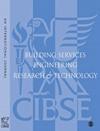Reduced multiple model predictive control of an heating, ventilating, and air conditioning system using gap metric and stability margin
IF 1.8
4区 工程技术
Q3 CONSTRUCTION & BUILDING TECHNOLOGY
Building Services Engineering Research & Technology
Pub Date : 2022-05-16
DOI:10.1177/01436244221100362
引用次数: 1
Abstract
In this paper, a reduced multiple-model predictive controller based on gap metric and stability margin is presented to control heating, ventilating, and air conditioning (HVAC) systems. To tackle the strong nonlinearity and large number of degrees of freedom in HVAC system, two approaches, called Reduced Order Model Bank-Multiple Model (ROMB-MM) and Multiple Model-Reduced Order Model (MM-ROM), are introduced. In the first approach, the order reduction is performed prior to multiple models selection and in the second one multiple models selection is implemented before the model order reduction. Furthermore, soft switching is employed to enhance the closed-loop performance as well as to gain optimal energy consumption. In order to evaluate the proposed approaches, a sliding mode controller is also simulated to compare the results in terms of energy and cost savings, transient and steady-state responses, and robustness against external disturbances and model uncertainties. Practical application: HVAC control systems are in charge of control indoor air temperature with energy optimization so that the thermal comfort is maintained. But how to model HVAC systems in each weather conditions is a significant challenge. A simpler and more accurate model will provide more efficient control of indoor air temperature. This paper suggests model order reduction and multiple model to select the simple linear model(s) in extreme weather conditions. The effectiveness of the proposed method can be implemented on nonlinear HVAC system.使用间隙度量和稳定裕度的供暖、通风和空调系统的简化多模型预测控制
本文提出了一种基于间隙度量和稳定裕度的简化多模型预测控制器来控制暖通空调系统。针对暖通空调系统的强非线性和大自由度问题,介绍了两种方法,即降阶模型组多模型(ROMB-MM)和多模型降阶模型(MM-ROM)。在第一种方法中,在多个模型选择之前执行阶数减少,并且在第二种方法中在模型阶数减少之前实现多个模型的选择。此外,采用软开关来增强闭环性能并获得最佳能耗。为了评估所提出的方法,还对滑模控制器进行了仿真,以比较能量和成本节约、瞬态和稳态响应以及对外部扰动和模型不确定性的鲁棒性方面的结果。实际应用:暖通空调控制系统负责通过能量优化来控制室内空气温度,从而保持热舒适性。但是,如何在各种天气条件下对暖通空调系统进行建模是一个重大挑战。更简单、更准确的模型将提供更有效的室内空气温度控制。本文建议在极端天气条件下,采用模型降阶和多重模型来选择简单的线性模型。该方法的有效性可以在非线性暖通空调系统中实现。
本文章由计算机程序翻译,如有差异,请以英文原文为准。
求助全文
约1分钟内获得全文
求助全文
来源期刊

Building Services Engineering Research & Technology
工程技术-结构与建筑技术
CiteScore
4.30
自引率
5.90%
发文量
38
审稿时长
>12 weeks
期刊介绍:
Building Services Engineering Research & Technology is one of the foremost, international peer reviewed journals that publishes the highest quality original research relevant to today’s Built Environment. Published in conjunction with CIBSE, this impressive journal reports on the latest research providing you with an invaluable guide to recent developments in the field.
 求助内容:
求助内容: 应助结果提醒方式:
应助结果提醒方式:


